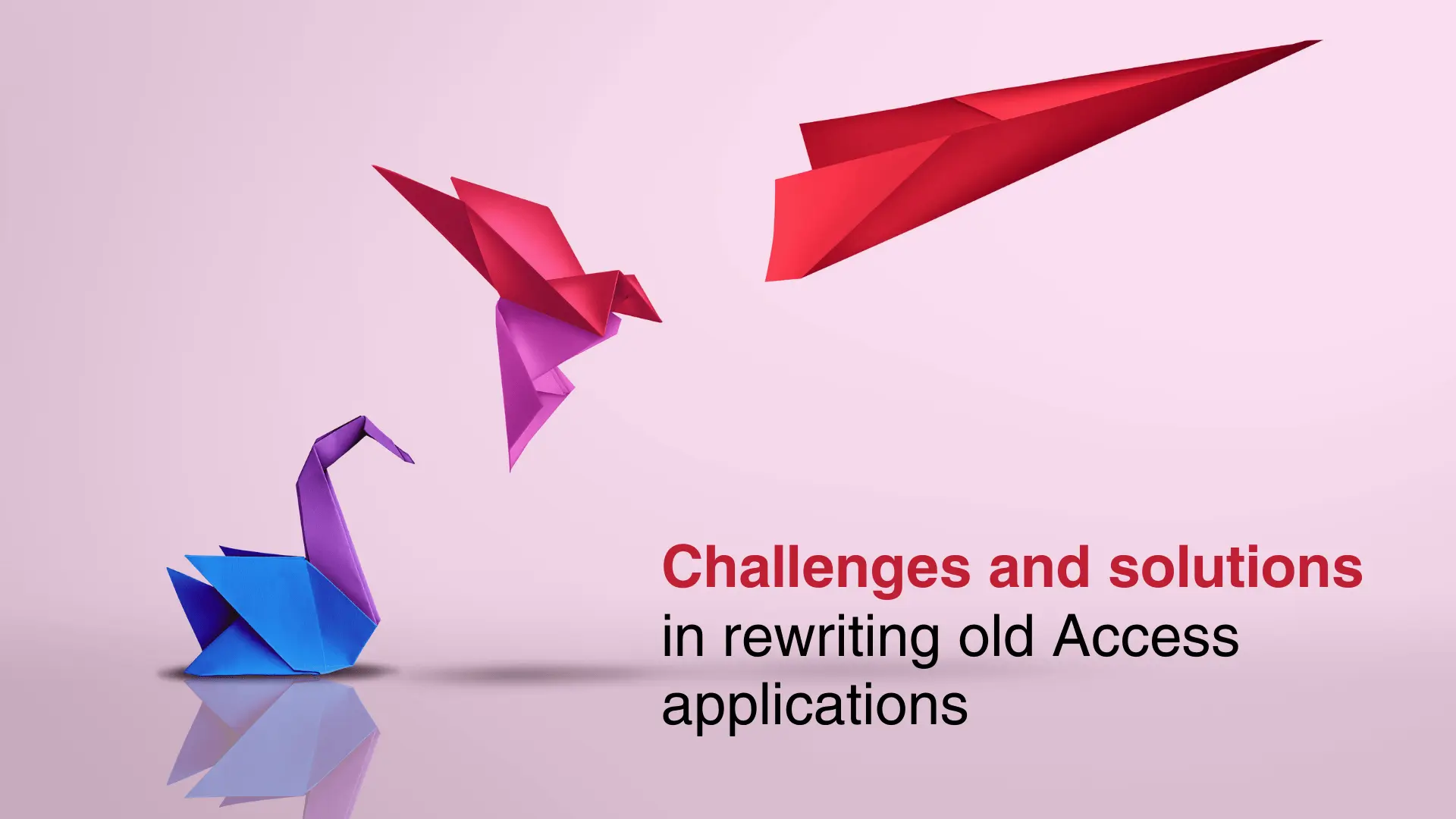Transforming an old Microsoft Access application into a modern web application is complex and challenging. Many organisations must upgrade their legacy systems to meet contemporary scalability, performance, and user experience requirements. Here are some of the most common challenges and possible solutions when rewriting old Access applications.
Challenges when migrating from Microsoft Access
Preservation of business logic
One of the biggest challenges when rewriting an old application in Microsoft Access is preserving the existing business logic. Access applications can contain complex macros and Visual Basic for Applications (VBA) code tightly integrated with the database. Extracting and translating this logic into a modern language such as C# or VB.NET requires careful analysis and planning.
Data integrity and migration
Access databases are often used to store critical business information. During a rewrite, it is essential to ensure that all data is migrated correctly and data integrity is maintained. This may involve converting data to a different format or structure, which can be complicated and time-consuming.
Have a backup if you intend to use the same database even after the migration. If the old Access application is used during development, a copy of the database can be used when developing the web version. The database may contain personal data, so you may want to pseudo-anonymise it. If you want to restructure the database instead, creating a conversion programme that can be used later when migrating data to the new web application is essential.
Scalability and performance
Microsoft Access is not designed to handle large amounts of data or many simultaneous users. When rewriting an application to a web application, choosing an architecture that can scale up to handle increasing load and user numbers is necessary. This may mean implementing a new database solution, such as MS SQL or a NoSQL database, and optimising the application’s performance.
User experience and interface
Access applications often have simple and limited user interfaces. A modern web application requires a more sophisticated and user-friendly interface. This means designing new UI components and using modern front-end technologies such as React, Angular or Vue to improve the user experience.
Broader accessibility
Microsoft Access applications are usually designed for use within a local network (intranet), limiting access to users on specific organisational computers. On the other hand, modern web applications can be made available over the Internet using any web browser. This allows users to access the application anywhere with an internet connection and on different devices, including desktops, laptops, tablets, and mobiles.
Solutions to overcome these challenges
Analyse and plan carefully
To ensure a smooth transition, a thorough analysis of the existing Access application is essential. Document all business logic, database structures, and user flows. Create a detailed plan for how each application part will be rewritten and migrated.
Use modern .NET technology.
C#.NET is an excellent choice for rewriting the business logic of a modern web application. Using ASP.NET Core, you can create a scalable, high-performance backend that can handle large amounts of data and many concurrent users. ASP.NET MVC and Web API can be used to build structured and modular applications.
Implement a robust database solution.
Choosing a robust database solution is essential for managing data integrity and migration. MS SQL Server offers advanced data storage and management capabilities, making it a good choice for most web applications. Use tools like ADO.NET and Entity Framework to interact easily with the database and ensure proper data transfer.
Improve the user interface.
To create a user-friendly and responsive interface, use modern front-end technologies like HTML5, CSS3, and TypeScript and frameworks like React, Angular, or Vue. Bootstrap can be used to create stylish and mobile-friendly user interfaces quickly. Focus on improving the user experience by making the interface intuitive and easy to use.
Ensure performance and scalability.
Implement caching, asynchronous operations, and load-balancing solutions to ensure your application can scale up to meet future needs. Cloud services such as Microsoft Azure or AWS can be exploited for their scalable infrastructures and services. In addition, you should prioritise security measures to protect your application and user data from security vulnerabilities. This is especially true when the database contains personal data, as the GDPR requires data protection by design and default. Here is another article on migrating to the cloud.
Test and validate
Finally, extensive testing of the new application must be conducted before it is launched. Validate that all business logic works as expected, that data is migrated correctly and that the user experience is improved. Automate testing tools and perform manual tests to ensure the application is stable and reliable.
Training and support for users
Transitioning to a new system often requires user training to ensure existing users can use the new application effectively. Adequately designed web applications are usually more intuitive and, therefore, easier to use than traditional applications. However, this does not mean that training is not needed. Providing comprehensive training and support documentation can ease the transition for end users.
To summarise
By carefully planning and using modern technologies, you can successfully transform an old application written in Microsoft Access into a modern web application that meets today’s performance, security, scalability and user experience requirements.
Do you need help?
If you need help migrating from Microsoft Access, don’t hesitate to contact us at Gislen Software. We have the expertise and experience to ensure a smooth and efficient update process. Whether you face technical challenges or need strategic guidance, we are here to help you achieve your goals. Contact us today to discuss how we can support your migration from Microsoft Access!
